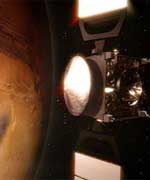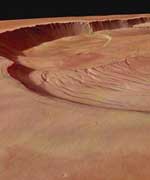The British National Space Centre has today published the report of the ESA/UK Commission of Inquiry set up to investigate the circumstances and possible reasons that prevented completion of the Beagle 2 mission.
The report was always seen by BNSC and ESA as an internal inquiry. Its purpose was to learn lessons for the future. There were also concerns about the confidentiality of commercial information. The organisations involved were given a strong indication that the information they supplied was only for the use of the inquiry. For these reasons the report was not published. ESA and the UK did however think it right that the recommendations of the report should be published as these covered the most important issues
The Science and Technology Select Committee was also confidentially given a copy of the full report. Subsequently, in view of the Committee’s strongly held view that the report should be published in full, we have discussed the issue again with ESA and have persuaded them that the report should be published.
We have also had further discussions with the other organisations involved about now publishing the report and they are aware that the report is being published today. The contents of the report have not been agreed with the parties.
A full copy of the report, including recommendations, can be found at the following website address: http://www.bnsc.gov.uk/assets/channels/resources/press/report.pdf
NOTES TO EDITORS
1. The Beagle 2 inquiry was launched on February 11, 2004, by Lord Sainsbury, UK Minister for Science and Innovation, and Jean-Jacques Dordain, ESA Director General, to investigate the circumstances and possible reasons that prevented completion of the Beagle 2 mission.
2. The Inquiry Commission was set up jointly between ESA and BNSC and was chaired by the ESA Inspector General. The Commission included senior managers and experts from Europe and also from NASA and Russia. Its remit was to:
assess the available data/documentation acquired during development, integration and testing of the Beagle 2 lander on Earth and that pertaining to the cruise phase operations prior to release of the spacecraft to Mars;
analyse the programmatic environment (i.e. decision processes, funding level and resources, management and responsibilities, interactions between the various entities) throughout the project;
identify possible issues and shortcomings, both programmatic and technical, in the above and in the approach used, which might have contributed to the loss of the mission.
3. The recommendations from the inquiry were published on May 24, 2004, when ESA also announced the lessons learnt from the inquiry and its plans to implement the recommendations.
4. The Beagle 2 project was led by the Open University, providing the science lead, and EADS-Astrium, the prime industrial contractor responsible for the main design, development and management of the lander.
5. The Beagle 2 lander was funded through a partnership arrangement involving the Open University, EADS-Astrium, the Department of Trade and Industry (DTI), the Particle Physics and Astronomy Research Council (PPARC), the Office of Science and Technology and ESA. Funding also came from the National Space Science Centre and the Wellcome Trust. UK principal investigators for Beagle 2 in the UK came from the Open University (gas analysis package), Leicester University (environmental sensors and x-ray spectrometer) and Mullard Space Science Laboratory (imaging systems).
6. BNSC is a partnership of Government Departments and Research Councils with an interest in the development or exploitation of space technologies. BNSC is the UK Government body responsible for UK civil space policy, to help gain the best possible scientific, economic and social benefits from putting space to work.
Original Source: BNSC News Release


